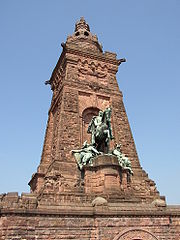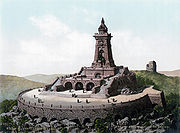
Kyffhäuser Monument
Encyclopedia


Monument
A monument is a type of structure either explicitly created to commemorate a person or important event or which has become important to a social group as a part of their remembrance of historic times or cultural heritage, or simply as an example of historic architecture...
on the summit of the Kyffhäuser
Kyffhäuser
The Kyffhäuser is a range of hills located on the border of the German state of Thuringia with Saxony-Anhalt. It stands on the southern edge of the Harz. The range has a length of and a width of . It reaches its highest point at the Kulpenberg , situated in Thuringia...
Mountain (highest elevation: 1,574 feet) near Bad Frankenhausen
Bad Frankenhausen
Bad Frankenhausen is a spa town in the German state of Thuringia. It is located at the southern slope of the Kyffhäuser mountain range, on an artificial arm of the Wipper river, a tributary of the Saale. Because of the nearby Kyffhäuser monument dedicated to Emperor Frederick Barbarossa, it is...
in the state of Thuringia
Thuringia
The Free State of Thuringia is a state of Germany, located in the central part of the country.It has an area of and 2.29 million inhabitants, making it the sixth smallest by area and the fifth smallest by population of Germany's sixteen states....
in central Germany
Germany
Germany , officially the Federal Republic of Germany , is a federal parliamentary republic in Europe. The country consists of 16 states while the capital and largest city is Berlin. Germany covers an area of 357,021 km2 and has a largely temperate seasonal climate...
.
The monument, which totals 81 metres (267 feet) tall, was built in 1890-96 to plans drawn by the German architect Bruno Schmitz
Bruno Schmitz
Bruno Schmitz , was a German architect best known for his monuments in the early 1900s, working closely with sculptors such as Emil Hundrieser, Nikolaus Geiger and Franz Metzner for integrated architectural and sculptural effect...
(1858-1916) atop the ruins of the medieval Fortress of Kyffhausen. The monument was initially proposed by the 19th Century German War Veterans Federation, which under the name Kyffhäuser Federation took over its maintenance after 1900.
Stylistically, the Kyffhäuser Monument recalls the castles and fortresses of the Hohenstaufen
Hohenstaufen
The House of Hohenstaufen was a dynasty of German kings in the High Middle Ages, lasting from 1138 to 1254. Three of these kings were also crowned Holy Roman Emperor. In 1194 the Hohenstaufens also became Kings of Sicily...
period in Germany in the 12th and 13th centuries. It was intended to suggest that the Prussia
Kingdom of Prussia
The Kingdom of Prussia was a German kingdom from 1701 to 1918. Until the defeat of Germany in World War I, it comprised almost two-thirds of the area of the German Empire...
-dominated German Empire
German Empire
The German Empire refers to Germany during the "Second Reich" period from the unification of Germany and proclamation of Wilhelm I as German Emperor on 18 January 1871, to 1918, when it became a federal republic after defeat in World War I and the abdication of the Emperor, Wilhelm II.The German...
founded in 1871 was the legitimate successor to the Holy Roman Empire of the German Nation
Holy Roman Empire
The Holy Roman Empire was a realm that existed from 962 to 1806 in Central Europe.It was ruled by the Holy Roman Emperor. Its character changed during the Middle Ages and the Early Modern period, when the power of the emperor gradually weakened in favour of the princes...
, which existed from the 10th century until 1806. It also signifies the national theme of decline and rebirth.
The monument features a 6.5 metre- (22 foot) tall sandstone
Sandstone
Sandstone is a sedimentary rock composed mainly of sand-sized minerals or rock grains.Most sandstone is composed of quartz and/or feldspar because these are the most common minerals in the Earth's crust. Like sand, sandstone may be any colour, but the most common colours are tan, brown, yellow,...
figure of the medieval Holy Roman Emperor
Holy Roman Emperor
The Holy Roman Emperor is a term used by historians to denote a medieval ruler who, as German King, had also received the title of "Emperor of the Romans" from the Pope...
Frederick I von Hohenstaufen
Frederick I, Holy Roman Emperor
Frederick I Barbarossa was a German Holy Roman Emperor. He was elected King of Germany at Frankfurt on 4 March 1152 and crowned in Aachen on 9 March, crowned King of Italy in Pavia in 1155, and finally crowned Roman Emperor by Pope Adrian IV, on 18 June 1155, and two years later in 1157 the term...
, better known as Barbarossa (meaning "The Red-Bearded"), who appears to just have awakened from sleep. Above him stands an 11-metre (36-foot-) tall bronze
Bronze
Bronze is a metal alloy consisting primarily of copper, usually with tin as the main additive. It is hard and brittle, and it was particularly significant in antiquity, so much so that the Bronze Age was named after the metal...
equestrian statue
Equestrian sculpture
An equestrian statue is a statue of a rider mounted on a horse, from the Latin "eques", meaning "knight", deriving from "equus", meaning "horse". A statue of a riderless horse is strictly an "equine statue"...
of Kaiser
Kaiser
Kaiser is the German title meaning "Emperor", with Kaiserin being the female equivalent, "Empress". Like the Russian Czar it is directly derived from the Latin Emperors' title of Caesar, which in turn is derived from the personal name of a branch of the gens Julia, to which Gaius Julius Caesar,...
William I
William I, German Emperor
William I, also known as Wilhelm I , of the House of Hohenzollern was the King of Prussia and the first German Emperor .Under the leadership of William and his Chancellor Otto von Bismarck, Prussia achieved the unification of Germany and the...
(Wilhelm I.), the first emperor of the Second Reich, designed by Sculptor Emil Hundrieser (1846-1911) in the neo-baroque
Neo-baroque
The Baroque Revival or Neo-baroque was an architectural style of the late 19th century. The term is used to describe architecture which displays important aspects of Baroque style, but is not of the Baroque period proper—i.e., the 17th and 18th centuries.Some examples of Neo-baroque architecture:*...
style. This composition expresses the monument's theme: That William I brought to fruition the unification of the German nation that had been so long desired since Barbarossa's time.
Towering over the monument is a 57 metre (188 feet) tower topped by a huge imperial crown. By climbing a 247-step stairway, one can reach the top of the tower and obtain an excellent panoramic view.
An adjacent building features exhibits depicting the medieval Kyffhausen Fortress and the Legend of Barbarossa, which held that Frederick Barbarossa, who died during the Third Crusade
Third Crusade
The Third Crusade , also known as the Kings' Crusade, was an attempt by European leaders to reconquer the Holy Land from Saladin...
, was sleeping under the Kyffhäuser Mountain and someday would awaken again to life when Germany needed his leadership.
The Kyffhäuser Monument is the third-largest monument in Germany, after the Völkerschlachtdenkmal
Völkerschlachtdenkmal
The Monument to the Battle of the Nations is a monument in Leipzig, Germany to the 1813 Battle of Leipzig, also known as the Battle of the Nations...
(Battle of Nations
Battle of Leipzig
The Battle of Leipzig or Battle of the Nations, on 16–19 October 1813, was fought by the coalition armies of Russia, Prussia, Austria and Sweden against the French army of Napoleon. Napoleon's army also contained Polish and Italian troops as well as Germans from the Confederation of the Rhine...
monument) in Leipzig
Leipzig
Leipzig Leipzig has always been a trade city, situated during the time of the Holy Roman Empire at the intersection of the Via Regia and Via Imperii, two important trade routes. At one time, Leipzig was one of the major European centres of learning and culture in fields such as music and publishing...
, commemorating a pivotal 1813 victory in the war against Napoleon
War of the Sixth Coalition
In the War of the Sixth Coalition , a coalition of Austria, Prussia, Russia, the United Kingdom, Portugal, Sweden, Spain and a number of German States finally defeated France and drove Napoleon Bonaparte into exile on Elba. After Napoleon's disastrous invasion of Russia, the continental powers...
, and the Kaiser Wilhelm Monument at Porta Westfalica
Porta Westfalica
Porta Westfalica is a town in the district of Minden-Lübbecke, in North Rhine-Westphalia, Germany. The name “Porta Westfalica” is Latin and means “gate to Westphalia”. Coming from the north, the gorge is the entry to the region of Westphalia...
, both of which also were designed by Bruno Schmitz.
Further reading
- Gunther Mai: Das Kyffhäuser-Denkmal 1896-1996; Böhlau Verlag; 1997; ISBN 3412023973
- Rudy Koshar: From Monuments to Traces: Artifacts of German Memory, 1870-1990; University of California Press, 2000; ISBN 0-520-21768-3.
External links
- Official website by the Kyffhäuser Tourist Association
- Kyffhäuserdenkmal

